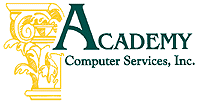CD Tower and Virtual CD Tower
Virtual CD/DVD Server
NAS
Networking
Legal Research Programs
Glossary
Downloads
Search
Email Us
Tel.: 800-385-6442
Fax: 781-279-4262
©2001 Academy Computer Services, Inc.
All rights reserved.
Terms & Conditions
Networking
Physical Setup
The Hub and Cables
The hub doesn't need to be literally in the center of your network. You don't need to place it equidistant from each computer in the middle of the office floor.
Place the hub in a dry, well ventilated place. The unit is an electronic device; so it will need a power supply and it will generate heat.
You can purchase ready made cables, called "patch cables", from computer dealers, office supply stores, and on-line merchants. You will need to know the length you need before you order the cable. Here are some tips on cable length.
![]() An Ethernet cable can be a maximum of 100 meters long.
An Ethernet cable can be a maximum of 100 meters long.
![]() The cable can go around corners, through holes in the wall, and in the ceiling. But they should never cross over a florescent light fixture or wrap around electrical wires - this creates electronic interference in the line.
The cable can go around corners, through holes in the wall, and in the ceiling. But they should never cross over a florescent light fixture or wrap around electrical wires - this creates electronic interference in the line.
![]() Although cables can curve, they should never have a crimp in them. You can snap the wires inside the cable doing this. And you must trust us when we tell you that this is a major problem.
Although cables can curve, they should never have a crimp in them. You can snap the wires inside the cable doing this. And you must trust us when we tell you that this is a major problem.
![]() The cable should not be taunt. This is not a clothes line.
The cable should not be taunt. This is not a clothes line.
The patch cable plugs into the hub on one end, and into the computer on the other.
NICs
Unfortunately every NIC is different, so its impossible to give specific directions for each one. you will need to follow the instructions that came with the device.
In general the steps that you will need to follow are:
- Shut down the computer.
- Open the computer case.
- Insert the NIC into an available ISA or PCI slot.
- Close the computer case.
- Turn the computer on.
- Follow the instructions that came with the device to load the driver.
![]() Some computers have the NIC built right into the motherboard. If this is true of your computer you will not need to perform any physical configuration of the computer.
Some computers have the NIC built right into the motherboard. If this is true of your computer you will not need to perform any physical configuration of the computer.
After the computer reboots, Windows will prompt you for further configuration information. You will be asked to give the name of the computer, the name of the workgroup it is a member of and the IP address of the unit. Each of these items should be established previously, as part of the Naming Standards.
Now that the hardware is configured you are ready for the next step: configuring the network.
